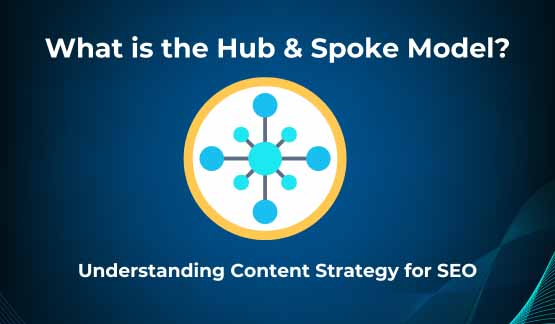Fact: Over 90% of web pages get zero traffic from Google. (Ouch.)
You put in the effort—writing blog posts, optimizing keywords, even tinkering with metadata—yet your content still isn’t ranking.
Why?
Because SEO isn’t just about keywords anymore.
Sure, keywords matter. But Google isn’t just looking at individual pages—it’s analyzing how your entire website is structured.
And if your content is scattered with no clear hierarchy, Google (and your potential customers) won’t know which pages are most important.
That’s where the Hub & Spoke Model comes in.
✅ It turns your website into an authoritative, structured resource.
✅ It signals to Google exactly what your content is about and why it matters.
✅ It helps you rank for not just one keyword—but entire topics.
If your website isn’t organized using this approach, you’re missing a huge SEO opportunity.
Let’s break down what the Hub & Spoke Model is, why it’s essential for modern SEO, and how you can use it to dominate search rankings.
What Is the Hub & Spoke Model in SEO?
Imagine your website as a wheel. At the center is the hub—your most important, in-depth piece of content on a topic. Surrounding it are spokes—supporting articles or pages that dive into related subtopics.
Each spoke links back to the hub, and the hub links out to each spoke, creating a strong internal linking structure that helps both Google and users navigate your site with ease. Instead of treating your website like a collection of isolated pages, this model connects everything into a cohesive content ecosystem—a structure that search engines love because it reinforces topical authority and improves discoverability.
How It Works in Practice
Let’s say you run an HVAC company. Instead of randomly publishing blog posts about heating and cooling, you organize your content like this:
🔹 Hub Page: The Complete Homeowner’s Guide to HVAC Maintenance
🔹 Spokes:
✔️ How Often Should You Service Your HVAC System?
✔️ DIY HVAC Maintenance: What You Can (and Can’t) Do Yourself
✔️ Signs Your HVAC System Needs Repairs
✔️ The Cost of HVAC Replacement: What to Expect
Each spoke supports and strengthens the authority of the hub, while the hub boosts the visibility of every spoke. The result?
✅ Higher rankings across multiple search terms
✅ More time on site and increased engagement
✅ Stronger internal linking that distributes authority across pages
This approach isn’t just about SEO—it’s a content strategy that makes your website more intuitive, structured, and valuable for both visitors and search engines. Instead of playing a guessing game with rankings, the Hub & Spoke Model aligns with how Google understands content today, positioning your site as an authority in your niche.
Why the Hub & Spoke Model Works
Google has one job: give users the best, most relevant answer—fast. If someone clicks a search result and doesn’t find what they need? They bounce. And if Google notices that happening a lot, guess what? That page starts slipping down the rankings because it failed to satisfy the searcher.
This is where the Hub & Spoke Model shines. Instead of leaving Google to piece together a dozen scattered pages, this structure clearly signals what your content is about, how it connects, and why your site is the best resource on the topic. That makes Google’s job easier—and when you make Google’s job easier, you get rewarded with higher rankings and more traffic.
Why Google Loves the Hub & Spoke Model
🔹 Google Needs to Understand Your Content—Fast
Search engines don’t just look for keywords anymore. They analyze topics, context, and connections between pages to determine how valuable your content is. A well-organized Hub & Spoke Model makes this easy:
✔️ The hub signals the main topic (your authority piece)
✔️ The spokes reinforce related subtopics (your supporting content)
✔️ Google sees the entire structure as a well-connected, high-quality resource
The result? Google recognizes you as an authority on the subject and ranks you higher.
🔹 Internal Linking: A Secret SEO Superpower
Google follows links to discover and rank pages. A scattered site with weak internal links? Harder to crawl, harder to rank. But when your hub links to each spoke and every spoke links back? That creates a clear, intentional structure that Google loves.
This setup:
✔️ Helps Google index your content faster
✔️ Boosts the authority of all linked pages
✔️ Guides users (and search engines) to your most important content
🔹 It Aligns with Search Intent
Google doesn’t just want any result—it wants the best result. The Hub & Spoke Model helps by structuring content in a way that directly answers users’ questions. Instead of isolated blog posts competing for attention, everything works together, showing Google that your site has depth, relevance, and complete answers.
🔹 More Engagement = Higher Rankings
Google tracks how long people stay on a page and how many pages they visit. If visitors bounce fast? That’s a bad sign. But a well-structured Hub & Spoke setup keeps users clicking, reading, and exploring—all signals Google rewards with better rankings.
✅ Users spend more time on your site
✅ They visit more pages (reducing bounce rates)
✅ Google sees your site as a valuable resource
Bottom Line? Google Loves What Users Love
The Hub & Spoke Model aligns perfectly with what Google values most: well-structured, helpful content that fully answers a user’s search query. It’s not just an SEO hack—it’s a content strategy that builds authority, improves rankings, and makes your site a magnet for organic traffic.
So if your website is a disconnected collection of blog posts, it’s time to rethink your approach. Because the sites winning in search today aren’t just optimizing for keywords—they’re structuring their content in a way that makes Google’s job easy.
How to Implement the Hub & Spoke Model on Your Website
Now that you know why the Hub & Spoke Model works, let’s talk about how to actually build one on your website. The good news? You don’t need a total website overhaul—just a smarter content strategy that structures your information in a way Google (and your audience) will love.
Step 1: Identify Your Core Topics (Your Hubs)
Your hub pages are the foundation of your content strategy. These should be broad, high-value topics that your audience is actively searching for and that align with your business.
🔹 If you’re a remodeling contractor: The Complete Home Renovation Guide
🔹 If you run a bookkeeping service: The Ultimate Guide to Small Business Accounting
🔹 If you own a med spa: Aesthetic Treatments 101: What You Need to Know
How to choose your hubs:
✔️ Look for high-traffic, evergreen topics in your industry
✔️ Choose subjects that support your services and expertise
✔️ Make sure there’s enough depth to build multiple supporting posts
Each hub page should be an in-depth, pillar piece of content (think: a 1,500+ word guide) that serves as the ultimate resource on that topic.
Step 2: Build Out Your Supporting Content (Your Spokes)
Once you have your hub, it’s time to create spokes—supporting pages or blog posts that cover specific subtopics in more detail. These pieces naturally link back to your hub, reinforcing its authority.
Example: A roofing company’s Hub & Spoke structure
🔹 Hub Page: The Complete Homeowner’s Guide to Roof Maintenance
🔹 Spokes:
✔️ How Often Should You Inspect Your Roof?
✔️ The Cost of Roof Repairs: What to Expect
✔️ DIY Roof Maintenance: What You Can (and Can’t) Do Yourself
✔️ How to Choose the Right Roofing Material for Your Home
How to create effective spokes:
✔️ Answer common questions your audience has about the topic
✔️ Target long-tail keywords (specific searches with clear intent)
✔️ Make sure every spoke links back to the hub (and vice versa)
Step 3: Strengthen Internal Linking for SEO
Your internal linking strategy is what turns your content from random blog posts into a powerful SEO asset. A strong Hub & Spoke Model should have:
🔗 Every spoke linking back to the hub
🔗 The hub linking out to every spoke
🔗 Spokes linking to each other when relevant
Why internal linking matters:
✔️ Google understands your site’s structure better
✔️ Pages distribute authority, boosting overall rankings
✔️ Users stay engaged longer, reducing bounce rates
💡 Pro Tip: Use descriptive anchor text for internal links (e.g., “Check out our complete Roof Maintenance Guide” instead of just “Click here”).
Step 4: Expand with Nested Hubs (For Bigger SEO Wins)
Once you build your first Hub & Spoke Model, you can scale up by creating multiple hubs—or even nested hubs, where spokes grow into hubs of their own.
🚀 Example of a hierarchical Hub & Spoke strategy:
🔹 Primary Hub: The Ultimate Guide to Home Renovation
➡ Spoke: Kitchen Remodeling: Costs, Timelines, and Tips (This could evolve into its own hub!)
➡ Spoke: Bathroom Upgrades: What Adds the Most Value?
➡ Spoke: Roofing & Exterior Improvements: What Homeowners Should Know
Each secondary hub can then have its own spokes, helping you rank for more competitive keywords over time.
Step 5: Monitor & Optimize Your Hub & Spoke Strategy
SEO isn’t “set it and forget it.” Once your Hub & Spoke Model is live, you need to track performance and refine your content over time.
📊 Check:
✔️ Are people engaging with your hub page and clicking through to spokes?
✔️ Do certain spokes rank well but need internal links for a boost?
✔️ Can you update or expand existing content to stay relevant?
Tools like Google Search Console, Google Analytics, and Ahrefs can help you identify what’s working, what’s not, and where you can improve.
Start Structuring Your Content for SEO Success
The Hub & Spoke Model isn’t just a “nice-to-have” SEO trick—it’s a proven strategy that makes your content work harder for you.
✔️ It helps search engines understand your site’s structure
✔️ It builds topical authority, making it easier to rank
✔️ It keeps visitors engaged longer, boosting SEO signals
If your website is a collection of disconnected blog posts, it’s time to turn it into a cohesive, high-authority content ecosystem. Implement the Hub & Spoke Model, and watch your rankings—and your traffic—take off. 🚀
Common Mistakes to Avoid
🚫 Mistake #1: Choosing Too Broad a Hub Topic
If your hub is too generic, it will be hard to compete. Instead of “Marketing Strategies,” focus on “Marketing Strategies for Local Service Businesses.”
🚫 Mistake #2: Not Connecting Spokes Properly
If your spokes don’t link back to the hub, they won’t reinforce its authority. Every spoke should reference the hub naturally.
🚫 Mistake #3: Neglecting to Update the Hub
Your hub isn’t static—as new content (spokes) are created, update the hub with fresh links and insights.
🚫 Mistake #4: Writing Content Without Search Intent in Mind
Spokes should answer real questions people search for. Research keywords with tools like Google’s “People Also Ask” or SEMrush to ensure you’re addressing high-intent queries.
🚫 Mistake #5: Ignoring Data & Analytics
Your internal linking strategy should be data-driven. Use Google Analytics to see which spokes drive traffic and adjust as needed.
FAQs About the Hub & Spoke Model in SEO
Can I create multiple hubs on my site?
Yes! If you offer multiple services or cover different topics, each one can have its own hub. Just ensure that each hub is distinct and doesn’t overlap too much.
💡 Pro Tip: Hubs can also be nested—a spoke from one hub can grow into a hub of its own over time. This is how websites gradually rank for higher-traffic, competitive keywords by building layers of structured content.
How do I choose the right hub topic?
Your hub should be a high-level, evergreen topic that:
✔️ Is broad enough to support multiple subtopics (spokes)
✔️ Aligns with your business services or expertise
✔️ Matches what your audience actively searches for
If you’re unsure, start by researching high-traffic keywords and checking out Google’s “People Also Ask” section to see what related questions people are asking.
How many spokes should a hub have?
There’s no set number, but a strong hub typically has at least 5-10 high-quality spokes.
🔹 If you’re just starting out: Aim for at least 5 well-researched spokes and grow from there.
🔹 For more established sites: The more in-depth your hub, the more spokes it can support—some sites have 20+ spokes per hub over time!
The key is quality over quantity—each spoke should provide valuable, unique insights rather than just rewording existing content.
Should spokes link only to the hub, or can they link to each other?
Both!
✔️ Spokes should always link back to the hub—this reinforces its authority and tells Google it’s the main resource.
✔️ Spokes should also link to each other when relevant—this helps users navigate your content naturally and improves internal linking for SEO.
Think of it as creating a web of related content that keeps visitors engaged longer.
What type of content works best as a hub?
Hubs should be comprehensive, in-depth resources that act as the go-to guide for a topic. Some of the best-performing hub formats include:
🔹 Ultimate Guides (e.g., The Ultimate Guide to Local SEO)
🔹 How-To Playbooks (e.g., How to Start a Home Renovation Project from Scratch)
🔹 Step-by-Step Roadmaps (e.g., A 12-Month Plan for Building Your Content Strategy)
🔹 Beginner’s Guides (e.g., Local Business Marketing 101)
How often should I update my hub?
At least every 3-6 months.
Your hub should evolve as you add new spokes, industry trends change, or search intent shifts. Regular updates signal to Google that your content is fresh, which helps with rankings.
📌 Quick ways to refresh your hub:
✔️ Add new spokes (and link them to the hub)
✔️ Update outdated stats or references
✔️ Improve readability and formatting
✔️ Add new internal and external links
Does the Hub & Spoke Model help local businesses?
Absolutely! Local service businesses benefit greatly from this model because it helps them rank for high-intent local searches.
For example, a plumbing company could structure its content like this:
🔹 Hub: The Homeowner’s Guide to Plumbing Maintenance
🔹 Spokes:
✔️ How to Prevent Clogged Drains in Your Kitchen
✔️ When to Call a Plumber vs. DIY Fixes
✔️ The Cost of Replacing a Water Heater
✔️ Signs Your Pipes Need Repiping
By linking these together, Google understands the site’s authority on plumbing, increasing its visibility in local search results.
Can I use the Hub & Spoke Model for eCommerce?
Yes! While this model is most commonly used for informational content, eCommerce sites can use it too.
🔹 Example for a fitness brand selling workout gear:
✔️ Hub: The Ultimate Guide to Home Workouts
✔️ Spokes:
• Best Dumbbells for Small Spaces
• How to Create a Budget-Friendly Home Gym
• Cardio vs. Strength Training: What’s Best for Fat Loss?
Each spoke can naturally lead visitors to product pages, creating a content-driven sales funnel.
Can I turn existing content into a Hub & Spoke structure?
Yes! You don’t have to start from scratch—you can restructure your existing content into a Hub & Spoke Model by:
✔️ Identifying a strong piece of content that could serve as a hub
✔️ Finding related posts that could work as spokes
✔️ Updating internal links so spokes connect to the hub
✔️ Filling gaps by writing new spokes to complete the topic
This is a quick way to boost SEO rankings without writing all-new content from scratch.
Key Takeaways: Why the Hub & Spoke Model is a Game-Changer
✔️ Google rewards well-structured content—the Hub & Spoke Model makes it easier for search engines to understand your site’s relevance, leading to higher rankings.
✔️ Users stay on your site longer—when visitors find clear, well-organized content, they engage more, click through to related topics, and see you as an authority in your field.
✔️ Internal linking strengthens SEO—linking spokes to a hub (and vice versa) distributes authority across your pages, helping all of your content rank better.
✔️ This strategy builds long-term authority—over time, adding spokes and refining your hubs helps you rank for high-traffic, competitive keywords, driving consistent, organic growth.
✔️ You don’t need to start from scratch—many businesses already have content that can be restructured into a Hub & Spoke format to boost rankings quickly.
The Hub & Spoke Model isn’t just a tactic—it’s a content strategy that scales. By implementing it on your website, you’re not just improving SEO—you’re creating a stronger, more authoritative online presence that delivers real value to your audience. Ready to put this into action? Start by identifying your core topics and mapping out your hubs and spokes today!









